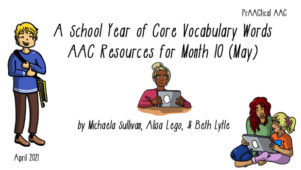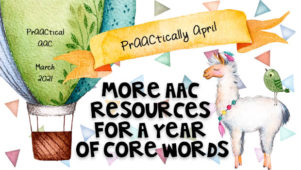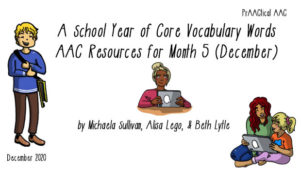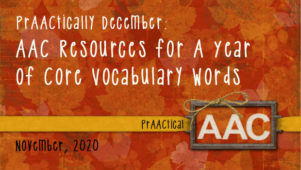School Year of Core Vocabulary Words: AAC Resources for Month 2 (September) by Michaela Sullivan, Alisa Lego, & Beth Lytle
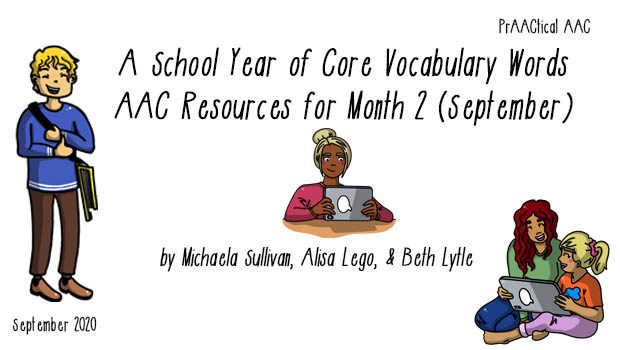
Though we are wrapping up the month of September, the core words selected for this month are high-frequency words that will live on throughout the year. Our new Year of Core Words School Edition is in development and the team is working hard to get these helpful posts to you prior to the start of each month so that you can plan and prepare your lessons and materials. Please bear with us for the first few posts as we get up to speed.
As with the previous post, these will each highlight a selected set of words along with a suggested order in which to teach them. We know that you’ll appreciate the Activity Packets with information sheets on highlighting these words in a variety of activities, and the accompanying data collection forms. A key intervention strategy is also discussed in each of these posts, with September focusing on the use of pause time.
If you are new to this series, you may want to review the introduction that our series authors created before delving into this month’s target words. You can see what Michaela, Beth, and Alisa wrote here.
Let’s get started!
A SCHOOL YEAR OF CORE WORDS
by Michaela Sullivan, Beth Lytle, & Alisa Lego
September has arrived and with it, so have new resources. If you’re looking for resources on core vocabulary, you are in the right place! These activities can be done at school, at soccer practice or at a park, anywhere where you can use language with your student, and if your student is your child, use these activities at home. To the parents, teachers, Speech-Language Pathologists, Para Professionals, friends, and other curious professionals or communicators – we hope you’re well and that your school year is off to a strong start. It’s different for many, if not all of us and we all want to take this opportunity to wish you all of our best as you spread the power of language to your students. You are here, seeking ways to engage your students and we celebrate you and embrace all that you do and we hope you find this month’s resources just as enriching than last month.
Enjoy Month 2 of the School Year of Core Words!
The Words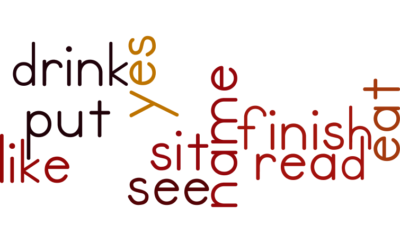
Level 1 words for September: you, eat, drink, yes, no, put, see, sit, like, on, off, finish, name, do, read, what
The suggested sequence for implementation is listed below:
- Week 1: you, eat, drink, yes
- Week 2: no, put, see, sit
- Week 3: like, on, off, finish
- Week 4: name, do, read, what
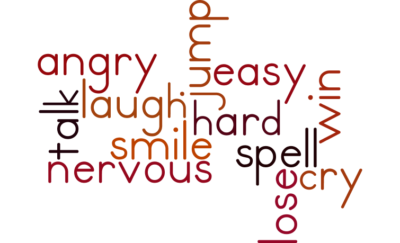
Level 2 words for September: was, did, jump, talk, smile, cry, spell, angry, laugh, nervous, easy, hard, win, lose, those, What’s up?
The suggested order for these words is listed below:
- Week 1: was, did, jump, talk
- Week 2: smile, cry, spell, angry
- Week 3: laugh, nervous, easy, hard
- Week 4: win, lose, those, What’s up?
THE SYMBOLS
You can download grids with the symbols for this month’s words from the lists below. These handy tools can help us remember what words to focus on and be useful in our intervention and instruction.
Level 1 Words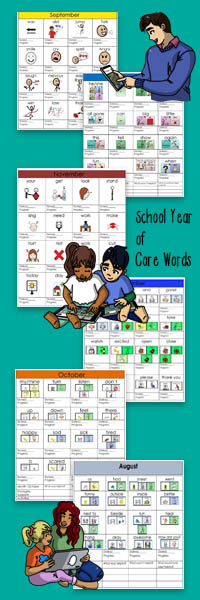
- Avaz
- CoughDrop
- LAMP Words for Life
- Wordpower 60 Basic
- Unity 45 Sequenced
- Unity 60 Sequenced
- Unity 84 Sequenced
- Blank Grid (add your own symbols)
Level 2 Words
- Avaz
- CoughDrop
- LAMP Words for Life
- Wordpower 60 Basic
- Unity 45 Sequenced
- Unity 60 Sequenced
- Unity 84 Sequenced
- Blank Grid (add your own symbols)
THE ACTIVITIES
These sets of Activity Packets are divided into weeks and can be downloaded for easy access.
Activity Packets for Level 1 Words
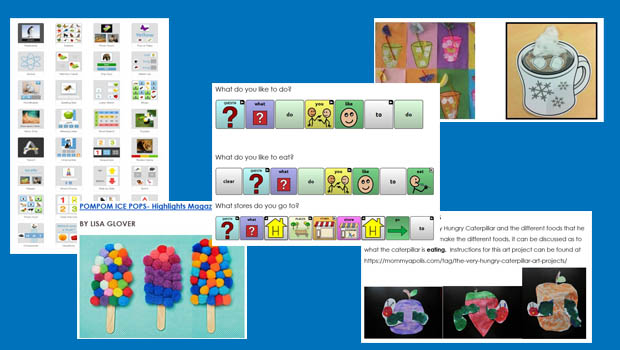 Activity Packets for Level 2 Words
Activity Packets for Level 2 Words
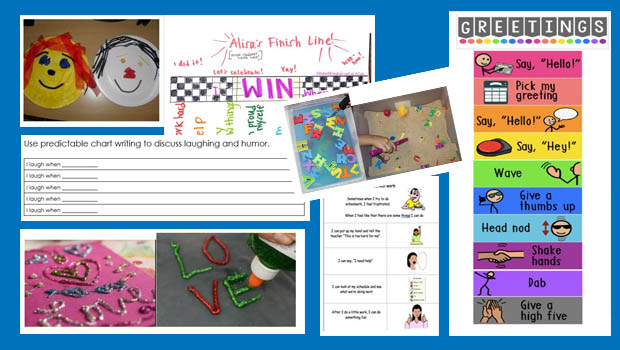
THE STRATEGY OF THE MONTH: WAIT TIME
As you know, individuals with complex communication needs who express themselves using AAC require more time to think of, formulate and express themselves. Providing adequate ‘wait time’ is an important consideration for communication partners while interacting and engaging with persons who use AAC systems. Sometimes the need to ‘wait’ may seem uncomfortable at first but over time, practice and when given focused attention, the amount of wait time needed for each individual will become more natural. As communication partners, we can wait expectantly for AAC users to respond and engage.
A study by Hilary Johanna Mathis revealed that the use of a wait time of up to 45 seconds supported users in expressing more words and engaging in more conversational turns (Assistiveware).
Please find the following additional resources on providing wait time below. These resources will be helpful for individual learning and/or for team training.
Resources
- On Not Talking (The Perfect Pause) by Carole Zangari
- The Do’s and Don’ts of Wait Time by Assistiveware
- How I do it: Teaching the AAC Helpers by Amanda Samperi
Videos
- Hannah Foley & Rachel Madel – Importance of Wait Time for AAC Users (Talking with Tech)
- AAC Teletherapy: Pronouns, Modeling & Wait Time by Sarah Gregory SLP (Sarah integrates the use of a visual timer to enhance awareness of wait time).
- AAC Tip #8 Wait by AT Department Staff – Special Education Services
DATA COLLECTION & ACCOUNTABILITY FORMS
Taking data to measure performance and keeping track of our own modeling behavior are two things we can do to strengthen our AAC teaching. Here are some forms that you can use to support those efforts.
We have expanded our core community, featuring 7 new core contributors:
- Abbie Duarte,
- Andriana Nikolau,
- Jessica Oseguera,
- Jordan Stuhltrager,
- Kelsey Robin,
- Molly Harzell, and
- Shanaz Faisal.
We want to welcome them and thank them for their dedication to sharing with others. You will find great variety in style and many additional resources from free printables, to Boom Cards and ideas on implementing the use of core vocabulary by using a variety of apps and websites.
To join our Core Community please email one of us with your ideas and resources (see the Activity Packets for our email addresses).
About the School Year of Core Vocabulary Series Authors
 Michaela Sullivan is an SLP who specializes in the fields of AAC and AT. She currently works within the San Francisco Unified School District on the AAC Support Team where she supervises graduate students, works in a transition program and on special projects. Ms. Sullivan is also an AAC and AT Team member within the San Mateo Unified School District where she developed an AAC Mentorship program. Ms. Sullivan also has a private practice. She has been a presenter in the field of SLP and AAC at state and national conventions. She serves as a board member and volunteer for the Nika Project, providing services, supports, resources, training, and repurposed equipment for individuals with complex communication needs both locally and internationally.
Michaela Sullivan is an SLP who specializes in the fields of AAC and AT. She currently works within the San Francisco Unified School District on the AAC Support Team where she supervises graduate students, works in a transition program and on special projects. Ms. Sullivan is also an AAC and AT Team member within the San Mateo Unified School District where she developed an AAC Mentorship program. Ms. Sullivan also has a private practice. She has been a presenter in the field of SLP and AAC at state and national conventions. She serves as a board member and volunteer for the Nika Project, providing services, supports, resources, training, and repurposed equipment for individuals with complex communication needs both locally and internationally.
 Alisa Lego is a second-year graduate student and candidate for Master’s of Science in Speech, Language and Hearing Sciences at San Francisco State University. Alisa is specializing in AAC through San Francisco State University’s federally funded Project Building Bridges. Alisa is also a candidate for the Autism Spectrum Graduate Certificate. Through Project Building Bridges, she has joined the Nika project and is providing resources for individuals with complex communication needs both locally and across the globe. You can follow Alisa on Instagram at @newfriendscollective.
Alisa Lego is a second-year graduate student and candidate for Master’s of Science in Speech, Language and Hearing Sciences at San Francisco State University. Alisa is specializing in AAC through San Francisco State University’s federally funded Project Building Bridges. Alisa is also a candidate for the Autism Spectrum Graduate Certificate. Through Project Building Bridges, she has joined the Nika project and is providing resources for individuals with complex communication needs both locally and across the globe. You can follow Alisa on Instagram at @newfriendscollective.
 Beth Lytle is a second-year graduate student and candidate for Master’s of Science in Speech, Language and Hearing Sciences at San Francisco State University. Beth is specializing in AAC through San Francisco State University’s federally funded Project Building Bridges. Through Project Building Bridges, she has joined the Nika project and is providing resources for individuals with complex communication needs both locally and across the globe.
Beth Lytle is a second-year graduate student and candidate for Master’s of Science in Speech, Language and Hearing Sciences at San Francisco State University. Beth is specializing in AAC through San Francisco State University’s federally funded Project Building Bridges. Through Project Building Bridges, she has joined the Nika project and is providing resources for individuals with complex communication needs both locally and across the globe.
Filed under: Featured Posts, PrAACtical Thinking
Tagged With: A Year of Core Vocabulary Words, Education & Schools
This post was written by Carole Zangari

